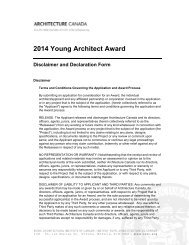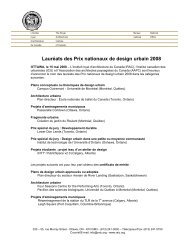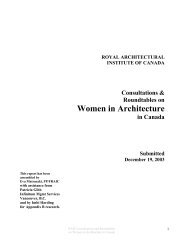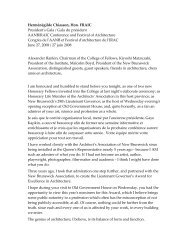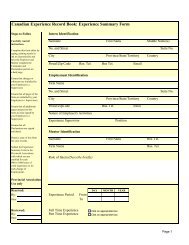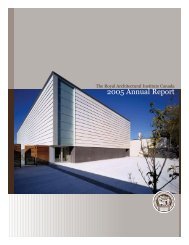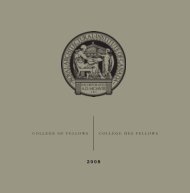Benchmark Study on Green Buildings - Royal Architectural Institute ...
Benchmark Study on Green Buildings - Royal Architectural Institute ...
Benchmark Study on Green Buildings - Royal Architectural Institute ...
You also want an ePaper? Increase the reach of your titles
YUMPU automatically turns print PDFs into web optimized ePapers that Google loves.
as many applicati<strong>on</strong>s as possible. In 1998, the subsidy was expanded to cover the<br />
installati<strong>on</strong> of PV systems for local government buildings and housing complexes. This<br />
caused more demand, and the subsidy fund had to grow accordingly, from 11.1 billi<strong>on</strong><br />
yen in 1997 (about $105 milli<strong>on</strong> Canadian), to 23.5 billi<strong>on</strong> yen in 2001 (about $222<br />
milli<strong>on</strong> Canadian). The value of the subsidy depends <strong>on</strong> the maximum capacity of the<br />
solar battery module making up the system. It was approximately 100,000 yen/kW of<br />
solar generating capacity in 2002, although this is likely to have decreased since then due<br />
to the c<strong>on</strong>tinually falling prices of PV systems.<br />
The NEF started the “Subsidy Program for Residential Solar Thermal Advanced<br />
Utilizati<strong>on</strong> Systems” in 2002 with the fund from METI. The program budget for 2002<br />
was approximately 5.8 billi<strong>on</strong> yen. A Solar Thermal Advanced Utilizati<strong>on</strong> System is<br />
c<strong>on</strong>structed from a heat accumulator, a heat collector and a circulating pump which<br />
circulates antifreeze through the unit. The heat collector should be installed adequately <strong>on</strong><br />
the roof to obtain the subsidy, and the system works for heating, cooling and water<br />
heating. The purpose of this program is to reduce the cost of the system so that it<br />
becomes more affordable and widespread. The gross area of this system (total area per<br />
heat collector x number of units) must be less than 25m 2 , and the subsidy grants a<br />
maximum of 150’000 yen per system.<br />
The 2001 “Interest Subsidizati<strong>on</strong> Program” gives companies installing renewable energy<br />
generati<strong>on</strong> systems lower interest rates when borrowing from financial instituti<strong>on</strong>s to<br />
cover these costs. The energy systems covered by this program include geothermal heat,<br />
waste heat, thermal energy c<strong>on</strong>servati<strong>on</strong>, power generati<strong>on</strong> using waste heat, wind power<br />
generati<strong>on</strong>, waste power generati<strong>on</strong>, solar power generati<strong>on</strong>, and hydro power generati<strong>on</strong><br />
systems. The NEF subsidizes the financial instituti<strong>on</strong>s, which then provide the companies<br />
with reduced interest rates.<br />
Building Centre of Japan (BCJ):<br />
The Building Centre of Japan (BCJ) is self-described as an incubator of new building<br />
technologies and helps their growth and acceptance into society. The BCJ performs a<br />
wide range of activities including evaluati<strong>on</strong>, research and development of new building<br />
technologies, and internati<strong>on</strong>al cooperati<strong>on</strong> and disseminati<strong>on</strong> of informati<strong>on</strong>. The BCJ<br />
c<strong>on</strong>tributes to the advancement of building technologies and the building industry, while<br />
improving the quality of life for Japanese people and people around the world. The BCJ<br />
has been involved in research involving many new building technologies and ideas,<br />
including hyper-buildings (a structure capable of housing 100,000 people that could stand<br />
for 1,000 years), arcologies (a term describing the merging of architecture and ecology,<br />
usually used in c<strong>on</strong>text with hyper-building or to describe a sustainable hyper-building),<br />
and sustainable building practices. Recently the focus of the BCJ has been <strong>on</strong> green<br />
building, assessment of the ISO 9000 and 14001 standards, globally disseminating<br />
building informati<strong>on</strong>, the review of various Japanese building codes and laws, research<br />
into prefabricated houses, green roofs, research into sick building syndrome, and<br />
innovative building technologies (recycling building materials, sound-insulated floors and<br />
walls, building materials with low VOC c<strong>on</strong>tent, heat-insulating materials that are not<br />
easily ignited, etc). When c<strong>on</strong>ducting evaluati<strong>on</strong>s of various building materials, each<br />
88



